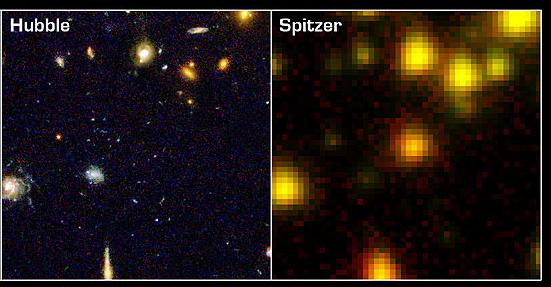Difference between revisions of "Galaxy Classification"
m |
m |
||
| Line 1: | Line 1: | ||
[[Image:Pn-gal.jpg|right]] | [[Image:Pn-gal.jpg|right]] | ||
=Serendipitous finds= | =Serendipitous finds= | ||
| − | Spitzer's cameras have relatively large fields of view (for infrared cameras), and Spitzer is really efficient at covering large areas of sky. Thus, it is often the case that sources are serendipitously imaged -- for example, galaxies caught in the background of an image of something else. You can do science with these objects! | + | Spitzer's cameras have relatively large fields of view (for infrared cameras), and Spitzer is really efficient at covering large areas of sky. Thus, it is often the case that sources are serendipitously imaged -- for example, galaxies caught in the background of an image of something else. You can do science with these objects.. science that the original astronomer who got these data is not likely to have done! |
| − | On the right is an example of just such an image. The picture is meant to be of the planetary nebula in the center ([http://www.spitzer.caltech.edu/Media/releases/ssc2005-07/index.shtml original press release]), but the galaxy in the upper right was caught by accident. | + | On the right is an example of just such an image. The picture is meant to be of the planetary nebula in the center ([http://www.spitzer.caltech.edu/Media/releases/ssc2005-07/index.shtml original press release]), but the galaxy in the upper right was caught by accident. The people who took this picture wanted to study the planetary nebula. They didn't care about the galaxy in the background. |
=Things to do with these galaxies= | =Things to do with these galaxies= | ||
Revision as of 19:47, 31 October 2007
Serendipitous finds
Spitzer's cameras have relatively large fields of view (for infrared cameras), and Spitzer is really efficient at covering large areas of sky. Thus, it is often the case that sources are serendipitously imaged -- for example, galaxies caught in the background of an image of something else. You can do science with these objects.. science that the original astronomer who got these data is not likely to have done!
On the right is an example of just such an image. The picture is meant to be of the planetary nebula in the center (original press release), but the galaxy in the upper right was caught by accident. The people who took this picture wanted to study the planetary nebula. They didn't care about the galaxy in the background.
Things to do with these galaxies
In this case, you can clearly see spiral arms. Here are some things you can do with galaxies you find in Spitzer images.
- Classify them. Start by going to Galaxy Zoo, learn about galaxy classification, and train your eye on how to recognize shapes of galaxies.
- Is the classification the same in the infrared as it is in the optical? Not necessarily! Go to, for example, Skyview and grab an optical image (or from any other wavelength for that matter) and see if you get the same classification.
- Are you the first person on the planet to think about this galaxy? Go to NED, the NASA Extragalactic Database, and search (by position is probably easiest) to see if anyone else has studied this galaxy before. Did they get the same classification as you did? What else do they know about this galaxy? Do you know something now that they don't know? (Has anyone published anything on Spitzer data yet?)
- How big is it in pixels, arcseconds, or (if you have a distance to the galaxy from NED) light years (or parsecs)?
- Does it have any friends nearby? Galaxies, like stars -- or teenagers -- usually tend to come in groups... where you find one, another one is usually not too far away. How far away is it from its friend? Is there any evidence that the two galaxies are close enough to interact with each other?
Spitzer's spatial resolution
 Despite the example above, where you can clearly see spiral arms in the galaxy, not every galaxy is so lucky.
Despite the example above, where you can clearly see spiral arms in the galaxy, not every galaxy is so lucky.
